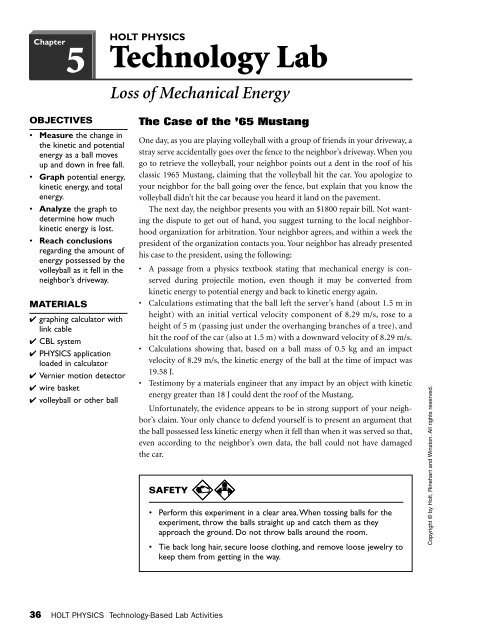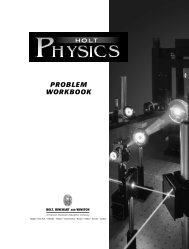TECHNOLOGY-BASED LAB ACTIVITIES
Lab Activities (PE).pdf - langlopress.net
Lab Activities (PE).pdf - langlopress.net
Create successful ePaper yourself
Turn your PDF publications into a flip-book with our unique Google optimized e-Paper software.
Chapter<br />
5<br />
HOLT PHYSICS<br />
Technology Lab<br />
Loss of Mechanical Energy<br />
OBJECTIVES<br />
• Measure the change in<br />
the kinetic and potential<br />
energy as a ball moves<br />
up and down in free fall.<br />
• Graph potential energy,<br />
kinetic energy, and total<br />
energy.<br />
• Analyze the graph to<br />
determine how much<br />
kinetic energy is lost.<br />
• Reach conclusions<br />
regarding the amount of<br />
energy possessed by the<br />
volleyball as it fell in the<br />
neighbor’s driveway.<br />
MATERIALS<br />
✔ graphing calculator with<br />
link cable<br />
✔ CBL system<br />
✔ PHYSICS application<br />
loaded in calculator<br />
✔ Vernier motion detector<br />
✔ wire basket<br />
✔ volleyball or other ball<br />
The Case of the ’65 Mustang<br />
One day, as you are playing volleyball with a group of friends in your driveway, a<br />
stray serve accidentally goes over the fence to the neighbor’s driveway. When you<br />
go to retrieve the volleyball, your neighbor points out a dent in the roof of his<br />
classic 1965 Mustang, claiming that the volleyball hit the car. You apologize to<br />
your neighbor for the ball going over the fence, but explain that you know the<br />
volleyball didn’t hit the car because you heard it land on the pavement.<br />
The next day, the neighbor presents you with an $1800 repair bill. Not wanting<br />
the dispute to get out of hand, you suggest turning to the local neighborhood<br />
organization for arbitration. Your neighbor agrees, and within a week the<br />
president of the organization contacts you. Your neighbor has already presented<br />
his case to the president, using the following:<br />
• A passage from a physics textbook stating that mechanical energy is conserved<br />
during projectile motion, even though it may be converted from<br />
kinetic energy to potential energy and back to kinetic energy again.<br />
• Calculations estimating that the ball left the server’s hand (about 1.5 m in<br />
height) with an initial vertical velocity component of 8.29 m/s, rose to a<br />
height of 5 m (passing just under the overhanging branches of a tree), and<br />
hit the roof of the car (also at 1.5 m) with a downward velocity of 8.29 m/s.<br />
• Calculations showing that, based on a ball mass of 0.5 kg and an impact<br />
velocity of 8.29 m/s, the kinetic energy of the ball at the time of impact was<br />
19.58 J.<br />
• Testimony by a materials engineer that any impact by an object with kinetic<br />
energy greater than 18 J could dent the roof of the Mustang.<br />
Unfortunately, the evidence appears to be in strong support of your neighbor’s<br />
claim. Your only chance to defend yourself is to present an argument that<br />
the ball possessed less kinetic energy when it fell than when it was served so that,<br />
even according to the neighbor’s own data, the ball could not have damaged<br />
the car.<br />
SAFETY<br />
• Perform this experiment in a clear area.When tossing balls for the<br />
experiment, throw the balls straight up and catch them as they<br />
approach the ground. Do not throw balls around the room.<br />
• Tie back long hair, secure loose clothing, and remove loose jewelry to<br />
keep them from getting in the way.<br />
Copyright © by Holt, Rinehart and Winston. All rights reserved.<br />
36 HOLT PHYSICS Technology-Based Lab Activities





